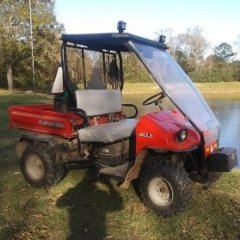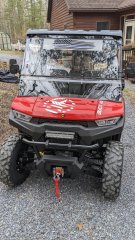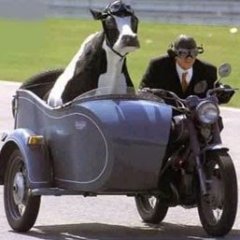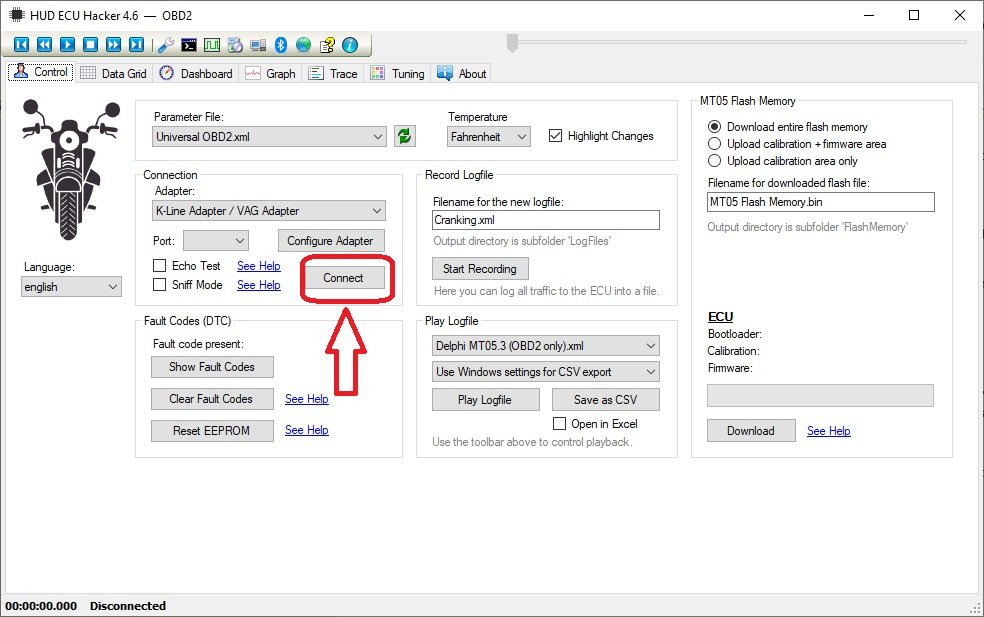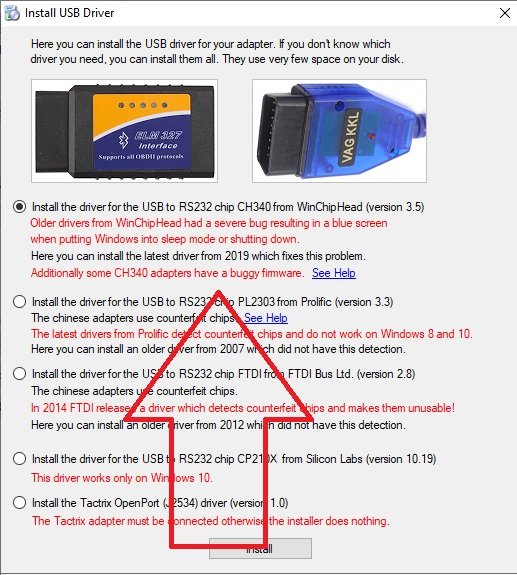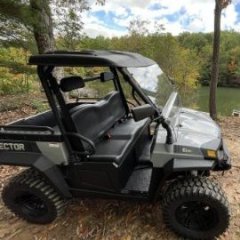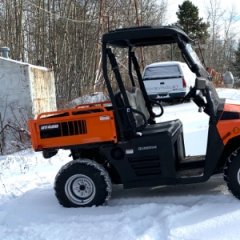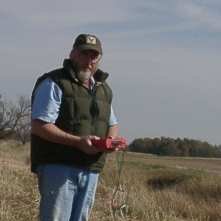Leaderboard
Popular Content
Showing content with the highest reputation since 04/27/2023 in all areas
-
Since I've seen some questions on this I took some pictures and will provide instructions on a valve adjustment for the UT400. This should be the same for the 550's and other various Coleman/Hisun single cylinder models with the cylinder slanted aft. I have seen several people ask of it is really necessary, and read several reports of valves being out of adjustment from the factory. My valves were .004" intake, and .010" exhaust with about 5 hrs on the machine. I've seen different numbers thrown around for factory spec, but I decided to go with 0.005". This is called valve lash. What is is is a gap between the rocker arm and the valve then the camshaft isnt opening the valve. Why does it matter? If it's too large the valve doesn't open all the way, if it's too small the valve dosent close. This can cause valve damage (overheating) as well as loss of engine power (burned fuel is going out exhaust rather than pushing the piston dow). Tools required : 5MM Allen wrench, 10MM box wrench, needle nose pliers, flat feeler gauge set, rags First you need to remove the fan cover on the passenger side. There is a cooling vent hose on the back side, remove the hose clamp and slide it off. From there there are 4x 10mm bolts holding the cover. The forward ones can be accessed from under the seat. Next remove the spark plug from the drivers side. Carefully wiggle the spark plug wire off. Grip it as low as possible and give it a little twisting motion as you pull it off to help free it. Its a tight fit for a socket, but there is a sheet metal wrench in the toolkit that fits it. Unscrew the plug and set it aside. This allows you to spin the motor over freely with no compression to fight. When you reassemble this is a good opportunity to switch to an NGK iridium plug for better performance/less fouling DR8EIX) Next you need to remove the intake and exhaust valve covers. The intake us the forward one. There are 3x 5MM Allen screws to remove. The Exhaust is the rear with 2x 5MM Allen bolts. Both covers have O-Rings instead of gaskets and are reusable. When you remove the rear be careful and use your rags as there will be oil that drips out. Next up we need to spin the motor over to top dead center. Grab each rocker arm and give em a little wiggle up and down. Spin the engine over by grabbing the fan with your other hand. Spin the engine over until both rockers have some wiggle and are loose. Once both rockers are loose slide the feeler gauge in like shown above. Try different feelers as needed to determine your starting spec. You should feel some drag but still be able to move the feeler without too much force. If you need to adjust, use the 10MM wrench to slightly loosen the locknut, then with the correct feeler gauge in place, tighten the top square nut while wiggling the feeler in and out. Once you have it right you need to tighten the 10mm lock nut without moving the square head bolt. Once the lock nut is tight recheck the clearance. That's it, button everything back up and make sure you have it all reassembled before running it again. If you find this helpful give me a thumbs up or comment. If you have any questions or need more help let me know. If there's interest maybe I'll do some more of these4 points
-
Hello to anyone who reads this. I am Jon and I own J&M Outdoor Power, a very small, small engine repair shop. I was approached by Coleman about 6 months ago to become one of their Warranty Centers. I recently received 3 different UT400's and a UT500 all with similar issues. These units range from 2 months to 2 years old. Customers state that the unit(s) was/were running fine, then heard a pop and a loss of power, two would no longer start. The two that would run would not achieve normal operating speed (around 20mph I would say) without redlining the RPMs. I quickly found that the Valve lash on each unit had become too large on some(both intake and exhaust) and too tight on one(just intake). After setting the gaps to .005(I found multiple different people suggesting bigger and smaller gaps, but no definitive Coleman Spec number yet) every unit starts, runs, and achieves top speed without issue. I don't know how many others have come across these issues, and I wanted to get something out on the web for others in the same predicament. Please let me know if you have had similar issues. Edit: I realize that this will not be a fix all solution for this issue, as the oil level and condition should be verified before moving to the valves. Many times improper oil conditions will cause valve lash to change. These units all have good oil and proper oil changes.3 points
-
Are you talking about an electric heater? if yes its likely too much current. There might be 10 amps of available current coming out of the rectifier that isn't already claimed by the ECU and factory lights. 10 amps @ 12V = 120 Watts, which is about what an electric heating pad runs. If you're talking about a fan for a engine coolant based heater it's probably ok. If you have accessories and the running voltage is below 13.5V you have too much stuff attached. If the battery light comes on it means the battery is actively being discharged while running. Stator based charging systems on these things and tractors etc are really meant to power the ECU and factory systems not to provide a lot of extra power for other stuff, it's not like the alternator on a car.2 points
-
2 points
-
The main trick is tilting the front end up. Block the rear wheels and jack up the front end at least a foot. A convenient ditch works well also.....rear wheels in a shallow ditch. The head bleeder screw should be opened. With the engine NOT running, almost fill the radiator (leave some air to avoid a mess) and burp (squeeze the lower hose line before the metal tube at the engine base passenger side floor area). Watch the radiator and the the bleeder. With the radiator "higher" than the head bleeder, the air should be bled and coolant dribble out. Close the bleeder and refill radiator (your clue you displaced the air with coolant) and start the engine. Burp more while running and if you get the circulation going the hoses will warm up. More bubbles should surface at the radiator filler neck. Shut off engine. Open bleeder and release any air in the head. The puke jug needs to be filled about an inch above the full cold line. Use a shop towel as a "seal"and use an air nozzle to SLIGHTLY pressurize the puke tank removing the air from the tubing line to the radiator neck. Then the radiator starts to overflow, a third hand can install the radiator cap. Run the engine and determine the head and hoses are at the close to the same temperature (as in warming up) through out the system. IR temp gun....fairly cheap now....can get real numbers. Scan the radiator, hoses, cylinder and head.....if all close you are done. Recheck fluids when done riding. Recheck the bleeder and top off the puke jug as required.2 points
-
From the look of the picture on the post, I can think of a couple things2 points
-
Its' not a car, this is a motorcycle engine with a small stator charging system. You can't expect to run high wattage accessories like a heater or huge light bars on these things . That will overwhelm the charging system, drain your battery an stop your engine. Could damage the charging system and voltage regulator too. You only have about 10 amps extra to run any accessories including lights.2 points
-
My dealer gave me an electronic version of the service manual and I have sent it to Kingfish. I will see if it will upload here for others to use. I'm not sure if there is a more appropriate way to do this, let me know if there is.. 2015-2017 Service Manual - Sector E1.pdf2 points
-
my Hisun in my Massimo , sold by Tractor Supply, assembled in Dallas, say Made In China on every part of all of it .. Altho it now has multiple Yamaha parts mixed in. lol2 points
-
https://motorcycledoctor.com/wp-content/uploads/2021/08/Valve-Adjustment-HiSun-2.pdf This should do it.2 points
-
Yeah, I adjusted mine multiple times without any luck. I had extended the shifter rod, as mentioned on this board, as well as some videos I watched, and that resolved the shifting issue. Now, after it slips into forward or Reverse, it never slips out. PS: If you go this route, remember to readjust the cable to compensate for the extended shifter. I had to do the adjustment an couple times after extending the shifter and then the problem was resolved.2 points
-
I finally found a service manual in stock and was able to make the adjustments per the specs!2 points
-
Problem was using cheap eBay injector. Bought quality one and hot pipes went away. Running like new.2 points
-
2 points
-
Massimo MSU500 won't shift to low I would check the shift linkage. Adjust it make it a little longer, if it is not long enough it won't shift to low2 points
-
Hello again! I now have a pretty good running Coleman UT400 after a top end rebuild, wet clutch rebuild and a repaired crankcase... ! It plows snow great, but I was also having the jumping out of gear problem, mainly reverse, but a couple times out of forward. I would quickly place it in N and then let the engine idle down and shift again. This worked most of the time. I did some research and found that some have modified the shift linkage. The problem with just adjusting the shift cable is that it really NEEDS more throw, not an adjustment. From what I've read and viewed on the Internet, the linkage arm needs to be about 3/4" longer to gain more throw in both directions. On YouTube, the guy had to remove the shift linkage hole trim and notch the side of the dash to get the shift linkage off the pivot pin. BUT this is NOT necessary. When the "E" clip has been removed and you fish it out of the firewall somewhere, the shift lever is now loose. I had to pop the top of the shift knob off, remove the retaining screw and then heat the lower portion of the knob to get it to come off the lever. Once you have the shift lever loose, push it towards the right to slide it off the pivot shaft. But it won't come off just yet. Use a small pry bar/screw driver and slide the nylon flanged bushing out of the left side of the lever. This lets the lever slide off and get into a "loose" condition and it will twist and come right off without removing the dash trim, that could be a bugger to get back on correctly. Once the lever is off, press out the other bushing so when you're welding on the linkage arm, you don't melt the bushing. I found a piece of scrap metal the same thickness as the lever arm, just over 1/8" thick, close to 3/16". I cut my arm and beveled the edges for better welding. I added a piece just over 5/8" long and kept about a 1/16" gap between the arm and the new piece. Once welded on bother ends, it adds up to just about 3/4" or so. I reinstalled the lever after painting it and did an adjustment on the cable. By the way, it's easier to remove the cable from the bracket on the frame. This gives you more clearance to maneuver in that area with your hands. ALSO, you will need to get a 12" adjustable wrench and slide it over the cable mounting bracket and tweak, to the front, the steel so the cable is pointed upward a bit to now realign with the new longer shift arm lever. There's more than enough metal for the tweak and it will line up perfectly. I now bottom out the shifter on the transmission BEFORE I run out of throw on the shifter... I've tested it just a bit so far and it shifts much better with the longer throw. One of the Coleman authorized repair facilities said that he worked with Coleman to get a new part that's longer by 3/4". He's modified a few and it works perfectly for him. Just doing the cable will just short you on the other end. Here's some pictures of my modified shift lever etc.2 points
-
In order to connect with the ECU we need two cables. The first is a USB ODBII cable. HUD ECU Hacker’s documentation has a lot of different confusing options, but here’s what I went with and managed to get working, the cable is called “VAG KKL” it is a USB to ODB2 cable. It is available from a variety of sources for $10-15. The second thing we need is a “6 pin delphi to ODB2” adapter cable. It is also available for a similar price. In my case I ordered both from ebay, but there are other sources. Once we have our cable in hand we need to find the plug it in on your machine. My personal rig is a Coleman UT400, but the wire location should be similar for all Hisuns. My cable was located under the middle of the seat area. Just inboard of the battery, where the main wire harness split loom runs. The cable is a 6 pin (3x2) with a dust cap. Remove the dust cap and plug in the 6-pin end of the Delphi adapter cable. Note: When I was done, I left the 6-pin adapter connected, and zip tied it so it now runs to in front of the battery for easier access in the future. Next download and install HUD ECU HACKER DOWNLOAD Open HUD ECU Hacker on your PC It should prompt you to choose a driver to install. This particular cable uses the “CH340” driver (First choice on the menu) click to install, once installed hit the X in the corner to go back to the main page Once the driver is installed plug in the USB Cable, and plug the ODB2 end into the 6 pin adapter. The red led on the adapter should light up indicating it has power. Drop down and pick a com port on the main screen, it should show the VAG KKL adapter as a com port. Click connect on the main menu. It will pop up a bunch of fast scrolling text indicating it is connecting. Once connected you can click through the various tabs to see different data sets. The main menu also has the option to show fault codes, clear fault codes, reset the EPROM back to factory. The other function that may be helpful is recording a log file. You can record a log while operating the unit, and come back later and replay it to try to better diagnose what is happening. Within the various pages you will see the reading from each sensor. Sometimes a sensor reading will be off enough to cause running issues, but not enough for the ECU to realize its an issue. For example if the engine thinks it’s really warm, but its actually cold, it may not inject enough fuel to start. There are also more advanced functions, like adjusting fuel mapping, but that is beyond the scope of this tutorial. Full HUD ECU Hacker Documentation (Very technical reading) If you find this helpful give me a comment below or a thumbs up.2 points
-
DO NOT BUY MASSIMO OR ANYTHING HISUN... you have been warned. You will regret it. They are Chinese junk..1 point
-
DON'T BUY A MASSIMO! The quality is soooo bad! I have a 2021 550 TBoss new when inventory of the decent brands was at rock bottom. I paid new what used decent brands were selling for. I quickly learned why. The quality is soooo bad. Out of the gate I had to make numerous adjustments to get it to run, drive and operate smoothly. Couldn't tow anything because the hitch receiver snapped off, the cheap plastic guards in front of the suspension parts broke off in no time, flooring cracked after a bit of use, windshield is now un clear and unusable after cleaning a couple of times (yes, I was extremely gentle), And all of the above and more on a machine I barely use (very low miles) I would love to sell it and buy a good one some day but I don't think anyone would buy it. Listen to all of the advice above and stay away from this brand!1 point
-
We see a lot of the UT400 with shift problems, not going into gear, popping out of gear, grinding etc. There is a bulletin Im sure everyone has saw about adjusting shift cable. That dont always fix it. I went round n round with coleman on couple units. We are a Coleman warranty repair center"AFS Small Engine Repair " I told them shift lever does not have enough travel . No amount of cable adjustment will increase travel . I extended lever with piece on flat iron by 3/4 of inch . This gave shifter enough travel to properly engage into gear completely . Last couple units to come in for this Coleman sent me a modified shift lever, with longer travel . Problem solved! Also , heads up if you get any new unit ,,,go over and check it out, grease all zerks, check air filter for being in backwards, check wiring harnesses for rubbing on rotating parts, brake hose routing , make sure not touching exhaust . These are just few of the more common failures I see .1 point
-
1 point
-
you'll have to get the axle nut off first. 1 1/16" If i remember right. the trick to getting the stuck drums off on these 550's is pb blaster,a hammer, and patience. also wouldn't hurt to open the bleeder on the back of the wheel cylinder to relieve any pressure.. spray the PBlaster between the drum and backing plate, let it sit and soak, and moderately tap around the drum, mainly focusing on the area around the cylinder... patience is KEY.1 point
-
Sorry about taking so long to respond. I did resolve the issue by replacing the carb again, but I'm not sure exactly what was wrong with the one that was on the engine. It definitely wasn't gummed up, because it behaved that way right after installation. I believe it was a factory assembly, but I seem to recall having to migrate the jets from my factory original carb. I suspect I forgot a part or otherwise messed up when moving them. With the carb that was acting up, I tried to back out the slotted plug from the underside (the bowl area), and it was seized into the aluminum threads. After mangling it with my screwdriver, I ordered another factory carb that came with the jets preinstalled. Before mounting it to the engine, I compared that new replacement to the one that was having issues. They were 100% identical except, when viewed from below, the slotted brass plug on my previous one was recessed about 1/4" higher up in the carburetor than the new one. So either I significantly over-drove it when installing the jets or I missed a part, such as an orifice disc, when assembling. I'll never know for sure, though, because there was no way I'd get that assembly apart without cutting it. The new-new factory carb has worked great for a couple seasons now with only a minor adjustment to the idle mixture.1 point
-
Hey Folks There are not a lot of good sources out there for troubleshooting and diagnosing ECU problems with the Massimo Buck, Bennche Bighorn, Bennche Cowboy, & Cazador machines that use the Delphi MT05 ECU. They are all basically the same with different badging, so I thought I'd share some info that I found during some searches. I was trying to help someone diagnose and repair a hard starting issue. The ignition coil was throwing a 0351 code. I discovered how to read codes without an OBDII code reader. The following procedures should help you check your fault codes and clear them if needed. Fault Code Troubleshooting for Delphi MT05 ECU on the Massimo Buck 400, Bennche Bighorn 400, Bennche Cowboy 400, and Cazador 400 *NOTE: The MT05 ECU is not really OBD 2 compliant. It is much more similar to an OBDI system. The MT05 ECU controls either 1 or 2 cylinder engines commonly found on Massimo, Bennche, and Cazador. Much of the ECU info was found here: https://netcult.ch/elmue/HUD ECU Hacker/Delphi MT05 Manual.pdf Delphi EFI System Design Delphi EFI employs 5 sensors to monitor engine performance. 1. Crankshaft Position Sensor 2. Coolant Temperature Sensor 3. Oxygen Sensor 4. Throttle Position Sensor 5. Manifold Air Pressure/Manifold Air Temperature (MAP/MAT) Sensor Delphi EFI employs the following system components. 1. MT05 Engine Control Unit (ECU) 2. Fuel Pump 3. Multec 3.5 Fuel Injector 4. Idle Speed Control Valve (Idle Stepper Motor) 5. Multec Ignition Coil 6. Fuel Vapor Canister Purge Valve Using the Digital Dashboard to Decipher EFI Trouble Codes In addition to commercially available diagnostic scan tools (Big $$$), you can use the engine warning light of the Siemens dashboard to diagnose most of your EFI problems. The digital dashboard receives signals from the MT05 ECU, and the engine warning light will flash a diagnostic trouble code (DTC) if the ignition key is switched on/off for three cycles. When you turn on the ignition, the engine warning light will illuminate, which indicates the EFI system is operational. After the engine is started, the engine warning light will extinguish if the EFI system is working properly. However, if the engine warning light remains illuminated, it indicates the EFI system is not working properly, and there is a system component failure. Deciphering Diagnostic Trouble Codes To read the diagnostic trouble code (DTC), open and close the ignition key three times in rapid succession, as follows: open/close—open/close—open. At this point the engine warning light will flash a DTC which indicates the fault in the EFI system. Refer to the attached fault code table to identify the corresponding problem. The engine warning light will emit a sequence of flashing lights. If the light flashes 10 times, the translated number is 0. If the light flashes one time, the translated number is 1, et cetera. For example, if the MAP/MAT sensor is disconnected, or the connector is shorted to ground, the engine warning light will flash in the following manner (This is an example only). The engine warning light will flash 10 times: The first number of the DTC is 0 After an interval of 1.2 seconds, the engine warning light will flash 1 time: The second number of the DTC is 1 After an interval of 1.2 seconds, the engine warning light will flash 10 times: The third number of the DTC is 0 After an interval of 1.2 seconds, the engine warning light will flash 7 times: The fourth number of the DTC is 7 The resulting DTC is P0107. NOTE: For the system I was helping to troubleshoot, I suspected an ignition coil failure due to the code that was thrown. When it was checked, it was flashing: 10, 3, 5, 1. The 10 represents a 0. So the actual code was 0351. After finding the code, the coil wire was checked and discovered loose at the spark plug. Once it was pushed fully on, the problem was fixed. Most likely, this problem was created after the owner had pulled the spark plug to check the gap. The ECU was rebooted using the procedures detailed below with no more codes being thrown. If there are other fault codes, the engine warning light will flash the next code in 3.2 seconds after finishing the first sequence. After all existing fault codes are flashed, the engine warning light will repeat the fault codes in a loop sequence, until the ignition key is turned off. To clear fault codes you either need an OBDII Fault Code reader and a Delphi 6 pin connector adapter cable that you have to order from China and wait 8 weeks…OR....you can simply reboot the ECU using the instructions detailed below. Rebooting the ECU Perform the following steps to reboot the ECU. 1. Turn off the ignition for 15 seconds. 2. Turn the ignition on/off for 5 cycles. Make sure each cycle lasts about ½ second, verifying the start of the fuel pump for each cycle. If the fuel pump doesn't start during any cycle, begin the entire reboot procedure from the beginning. 3. Turn off the ignition for 15 seconds. TPS (throttle position sensor) re-learn procedure after rebooting ECU. This should be done after replacing the TPS or the ECU....and it is advisable to check proper idle after rebooting an ECU too. Source: ECU Hacker (Reworded process slightly to make it a more sensible flow in my mind): 1. Turn the idle screw one full turn clockwise before starting 2. Start the engine, and run at low idle until the engine warms. Maybe a couple of mins. 3. Idle should be above 1500 rpm. If it isn’t, turn it up to 1700 then shut the engine off. Do another reboot of ECU. 4. Restart the engine and let it stabilize at 1700 rpm. Then turn the idle screen down to 1500 rpm and let it stabilize for a few seconds. Once it stabilizes, set to the final recommended idle speed for your machine. The placard under (or behind) your seat should show idle speed, valve adjustment, spark gap, etc. Typically the 390 cc engines in the "400" machines run at 1600 rpm idle. 5. Shut it down. Wait 10-15 seconds before restarting. The procedure is now complete. Final Notes: I have included pictures of an OBDII connector and the Delphi 6 pin connector in case anyone wants to go buy stuff off ebay or local parts suppliers and build a connector to use for an OBDII reader. But...you can save money and simply do the same thing with code reading and resetting using the check engine light on your dash. Some folks prefer to do it with code readers. Hope the information provided helps if anyone ever needs it but cannot find it in repair manuals. I discovered most of this in some motorcycle forums. The source for the diagrams is here: https://netcult.ch/elmue/HUD ECU Hacker/ Be advised: I am not a service technician. I do not endorse any manufacturers. I do not get paid to help, nor do I want to. This is just a hobby of mine. I enjoy working on things and solving problems. If you run into a weird problem that stumps you, give me a shout. I may be able to give you some ideas...or not. Just know, that troubleshooting thru emails can be challenging. The more info you can provide, the better. Otherwise, I will probably ask you a ton of questions. The good news is, the Delphi system used on these machines is essentially an OBDI and it is very simplistic. If you are methodical and patient, most of your "problems" can be figured out thru a process of elimination. Always go for the simple things first before throwing money and sensors at a machine. Take care - JT1 point
-
I have a 1999 Mule 550 which only had 25 psi on compression test. Leak down test indicated cylinder or rings issue, as I could clearly hear the air leaking when I removed the dip stick. Nothing out of the exhaust, & maybe a little out of the intake. I've removed the head, & there's a lot of carbon build up on the valves. I've ordered new valves, & am engine rebuilt kit, complete with piston & rings. When you pulled your piston, did you remove the engine, or were you able to remove the piston while the engine was in the frame? Thanks! I made the mistake of buying this sight unseen while I was deployed, & didn't think about asking for a compression test prior to paying.1 point
-
1 point
-
yes I can hear it clearly.. sounds like a knock to me. With Massimo it could literally be anything.1 point
-
1 point
-
Rainman, six months, 100 hours, or 1000 miles is a general interval for ATV/UTV oil changes. Searching for hisun/colemans recommended intervals only turn up 800 numbers. The seafood is made of mostly naphtha and isopropyl alcohol. That stuff will destroy any seals, plastic, rubber, rust, etc it comes into contact with. Known to ruin injectors, so user beware. Hopefully you got your situation figured out, and take it slow in the driveway.1 point
-
Rainman I found out that it was my valves needed to be adjusted so I adjusted them to the specs which was.005 and I will fire up perfectly like new hopefully this can help you1 point
-
Creeping down our steep driveway after a 3 mile hilly run. Using the engine to help break. I'm in 4WD and Low "gear" mode. Suddenly there is a "release" type pop and the engine is no longer breaking as sometimes happens over a certain speed. No problem I apply more breaks and come to a rest down the hill. BUT this time the "back up" alarm is beeping and now the engine is just dead. Error code was initially 54C 2 but after resting overnight it now says 54C 3. As soon as the key turns on I get the alarm and nothing from the motor. It does look like the flashing engine thing shows a square box in the middle front is flashing. I have tried to find those codes but no luck yet. I wouldnt know what to do with them anyway. Any insights appreciated.--Bill1 point
-
1 point
-
Your video is the tell.......you have belt rotation at idle Your belt is rotating AT IDLE with the primary sheaves.......that is a big NO NO. The rear sheaves (transmission input) always pinch and fit tight to the belt sides. The top of the belt is NORMALLY FLUSH to the outer rim of the rear or driven sheaves......your video looks like it is running "deeper" into the sheaves. The front sheaves should be open wide enough for the belt to flop (SIDE CLEARANCE at BELT EDGES) around when the motor is off and then sorta "drag the belt forward" BUT NOT PULL AND ROTATE until the engine Revs go up and thus tighten....as in close and pinch against the belt sides thus making the belt rotate. Go thru the motion of starting to remove the belt again. I assume you are using the rear hub squish screws to "open" thus get some belt slack. Now, in Neutral, with the belt loose, see if it will slip on the drive pulley. On other words, the belt will not "rub" on the sides meaning the front sheaves are opening wide enough for clearance at idle. Compress the rear pulley springs (open up the sheaves) and remove belt to test the action of the drive pulley. Start engine, run at idle, then raise RPMs and watch the drive pulley sheaves collapse together....get narrower....with increased Rs. Drop throttle and the sheaves should return to the wide open distance at idle. I have seen where the cords from a blown/shredded belt get under the shaft bearing (the cylinder sleeve that you see between the drive sheaves) and restrict the required sheave distance travel. If this is the case, the drive sheaves won't open enough and drag tension on the belt and "pull it deeper into the rear pulley"......which the video shows. Like buying the wrong belt and it is not long enough. Take the belt and lay it around only the rear pulley. See if it will ride at the top of the sheave rim with the squish bolts removed. If it does, your problem is with the front or a wrong belt. The drive pulleys spring will REACT to the belt tension. More tension pulls the belt in DEEPER...and that is how it works.....all controlled by the engine RPM and flyweights at the front drive pulley. Speaking of flyweights and the slide bushings wear will also limit the travel of the drive sheave width. Next, load the belt into the front pulley. It should sit deep into the sheaves and have side clearance to where you can pull the belt freely back and forth. BTW, older Polaris drive pulleys had a grooved inner bearing sleeve and the OEM belt had matching grooves in the inside. Some aftermarket belts had the grooves BUT the number and spacing was off....that small amount of "extra material" would cause the belt to drag and pull at idle.....let off brake and away it goes. Bottom line, it is a juggling act for the whole setup to work.1 point
-
I'll start by saying i'm learning as i go & have come a long way, but there are some maintenance issues on my mule sx that must be addressed & i've got nobody around with experience & cannot bring it to a shop. I've got rolling resistance when i jack up the front wheels. Months ago i thought i was possibly a brake issue but didn't yet have the equip. to pull the wheel hubs or press them back on... but the noise/friction seemed to resolve itself. I just checked up on it because i've got the tools for dealing with the brake system now and i noticed the wheels dont really spin... theres a lot of resistance and i can hear it coming from the front diff. I can't remember if it used to do that before, but i dont think it did. Its not the drive shaft or u-joints, but i've yet to pull them to be certain. it really sounds like its in the front diff. just where the drive shaft connects. Should the front wheels - when in neutral and in 2wd and no diff. lock - spin freely? Theres too much drag for mine to even go once around. Can anyone point me in a direction? Otherwise its trial and error with cv axles, ball joints, brakes, etc. and i dont have the $ or time for that. I'm in over my head and really hoping someone can help. I'll try to make a video of whats happening, hopefully the sound will come through well. Maybe that will help diagnose it. Thanks.1 point
-
This is all to to me as well, I can't say I know the answer to that, wish I did though. When I turned the soleplate I noticed the squeak. I did like I said and noticed the squeak went away. At that point I was happy and unfortunately I didn't really pay attention to how freely it spun. I am going to need to do some maintenance here soon as I'm starting to hear the squeak again, its not as bad , but its there. It could be just in need of some cleaning.1 point
-
ECU Rev Limit.cdr (motorcycledoctor.com) This should take care of it. Check out his advice & knowledge page which is where I got this from.1 point
-
If you look at the Hisun parts catalog (Alpha-Sports.com) it shows a cap for a carb engine and a different one one for an EFI engine. I'm certain they can assist you in getting the correct gas cap. It sounds like you have enough time invested now with the 400 that you should just fix it and enjoy it. Unless it had an excessive amount of hours on the hour meter or you find something major wrong, I think you did OK on the price. I bought a 2021 (in 2021) outfitter 550 and love it.1 point
-
Don't worry too much about the steering wheel alignment, for now that is. Do your toe in adjustment and while the outer tie rod end jam nuts are loose, you can take the six steering wheel cover off with a 4mm Allen wrench. Loosen the nut holding the steering wheel on and unthread it so it's flush with the end of the steering shaft. Use your knees or have someone lift up hard on the steering wheel while you hammer the nut/shaft to break it loose. I use two hammers. One ball peen hammer on the end of the nut /shaft and use the second one to hit the first one. A couple good whacks and the steering wheel will come loose. Then unthread the nut and pull off the steering wheel and realign the shaft splines and the steering wheel to make it straight again. You may have to readjust your tie rods a bit to get true center on the steering wheel. I adjusted my toe IN to about 3/16" on each side. Also, you'll have to release the two inner tie rod boot cover outer clamps so the tie rods can turn without winding up the rubber boots. Don't forget to reclamp the boots. I said a lot of words, but it's really quite simple. Good luck, Dan1 point
-
Yeah with the Yamaha timing components, cam and valves the motor was better and maybe that cratered the trans? So a Yamaha motor will probably gut the axles... Sent from my moto g stylus using Tapatalk1 point
-
As of today i have 4 units waiting for updated shift lever . Calling again to find out status . Its nothing new, they have always been horrible about contacts, replies , parts order time frame. I just go with thte flow . You get what you pay for . These units look nice , and actually preform pretty well for the cost . When yu have a Chinese company "Hisun " subbing out prduction to a Vietmese company to build a low cost UTV ,kinda get what you get. Other than the shifter issue, wheel bearings not torqued etc they are pretty decent . Looks like they cloned a Yamaha Rhino . If shift levers are not avail I may start producting some myself . Need to figure out cores, shipping etc .1 point
-
I just picked up a 2021 Coleman UT400 and one of the things it needs is a gas cap. I believe it needs the 2021+ version with mail threads. Anybody know where I can get one? Coleman isn't shipping anything out right now. I believe the part number is P315001811400000. The only after market gas caps I see available are before 2021.1 point
-
most likely translation error, I have the massimo wet clutch oil1 point
-
My bad. Don't read so good. LoL Glad you got it fixed. My Axis had a tie rod lock nut loose at 75hr. You are correct. The toe is the life of the tires and should be checked before hour 1 is put on it. 1/4 inch is 6.3mm (+ -) Enjoy the ride and be safe this summer1 point
-
Chris, thought I'd throw this out to will until more informed members help you out. There are some here that have more knowledge on these things than Myself. I own a 2016 MSU 800. In 7 yrs I have very few problems with mine. Mainly brake pads which I consider a wear item and wheels bearings a couple times. Mine has sealed wheel bearings as opposed to roller bearings that can be maintained, the only maintenance of sealed bearings is run them until they wear out and replace them!! On me machine if it gets to where it doesn't shift well it's usually the adjustment on the shifting linkage, which in my opinion is quite touchy, therefore it doesn't take much for it to get out of adjustment.1 point
-
My wife and I made the 1.5hr trip and picked up our new CanAm Defender XT HD9. So far I really like it and I'm happy with our decision. I also got the new front and back windshields from Rad Accessories. I chose the light tint on both. Super easy install as they come assembled just twist and lock. I also installed my SuperATV rear view mirror. I also removed the door nets after I took these pictures. The power steering is great and for a 975cc engine it is very quiet. I still plan to add some of the under seat storage tubs, a LED light bar on the front bumper, maybe one on the top of the windshield and a couple of pod lights on the back of the cab for rear lights.1 point
-
Just out if curiosity how many miles/hours did you put on it? What exactly are they saying the issue is? Frequently commercial use shortens or negates warranties so that doesn't entirely surprise me.1 point
-
This may work. Works for my Axis which is made by hisun just like the Massimo. Begin with the machine off. Cycle the key on and off 5 times within 5 -10 seconds. Making sure the fuel pump kicks on each time. After the 5th key off. Wait 30 seconds then start. Should be reset.1 point
-
Jbs machines sheave kit will give you more top speed. Rhino 700 kit will work.1 point
-
1 point
-
Well I have definitely got the same problem bought it brand new a 2018 cub cadet challenger 750 and have had it 2 years now haven’t been able to ride it more then a couple weeks at the time only 200 hours in and has a new timing chain tensioner all new clutches wet primary and secondary new belt new weights new spring new water pump new exhaust and it still over heats after 5 minutes of running1 point
This leaderboard is set to New York/GMT-04:00




